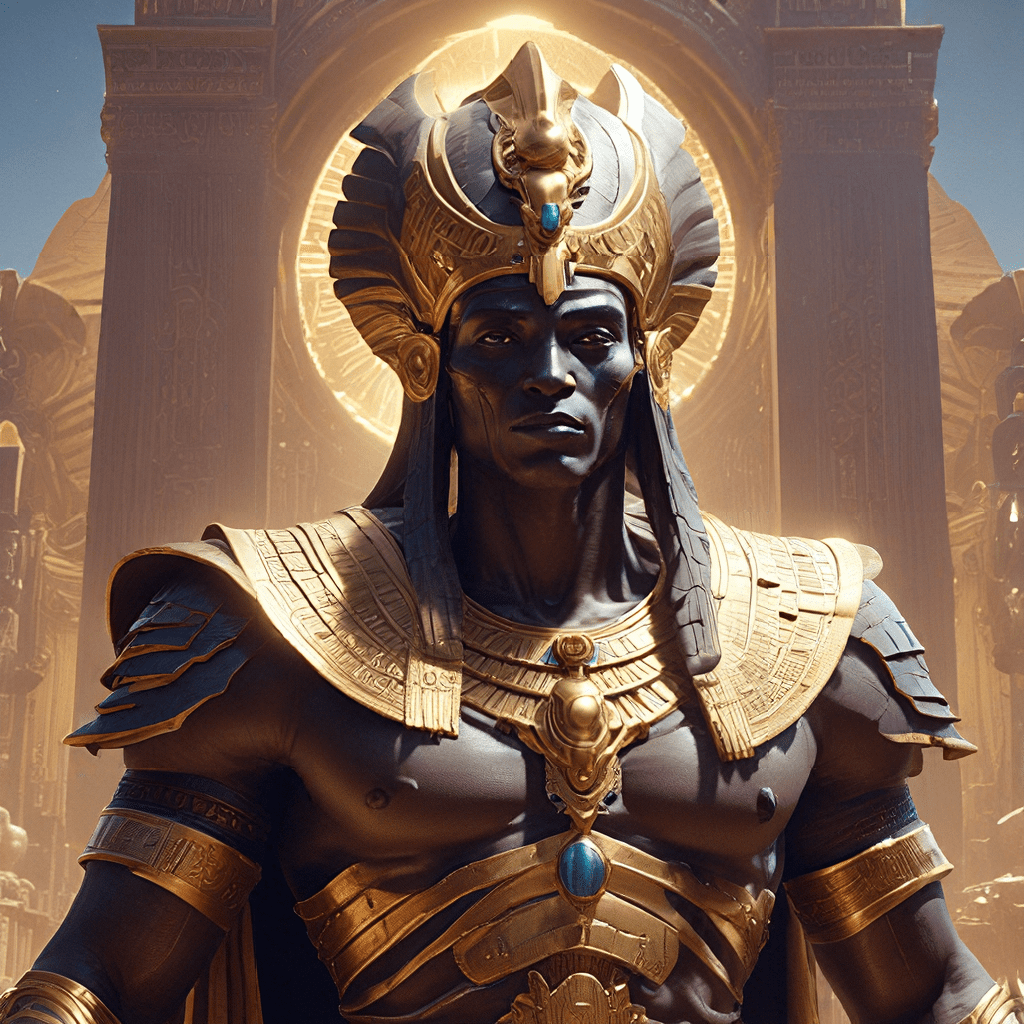The Birth and Early Life of Osiris
Osiris, the Egyptian god of the afterlife, was a powerful and influential figure in ancient Egyptian mythology. He was believed to be the son of Geb, the earth god, and Nut, the sky goddess. Osiris’ siblings included Isis, Nephthys, Set, and Horus. Osiris was often depicted as a green-skinned man, sometimes with a feathered crown or a mummified body. He was responsible for bringing order and civilization to ancient Egypt. He taught people agriculture, law, and other essential skills. Osiris’ was said to be a benevolent and just ruler, and his reign was known as a golden age. He was revered for his wisdom, compassion, and ability to judge the dead fairly.
The Reign of Osiris: A Golden Age
During Osiris’ reign, Egypt thrived. He introduced agriculture, which allowed people to settle in one place and grow crops. He also brought about a system of laws, which helped to establish order and fairness in society. He taught people how to build homes, boats, and other essential structures. Through his teachings, Osiris helped to transform Egypt from a primitive society into a sophisticated and advanced civilization. With his wisdom and guidance, Egypt experienced a golden age – a time of peace, prosperity, and advancement. His rule was marked by harmony, justice, and a flourishing civilization. Legend says that during this time, the land was fertile, crops grew abundantly, and the Nile River flowed smoothly, providing sustenance and prosperity.
The Murder of Osiris by Seth
Osiris’ brother, Seth, was a jealous and envious god. He resented Osiris’ popularity and power. Seth craved the throne for himself. One day, Seth tricked Osiris into entering a coffin. Then, he slammed the lid shut and tossed it into the Nile River. Seth’s act of treachery brought an end to Osiris’ reign and threw Egypt into chaos. The murder of Osiris, a beloved and respected ruler, shocked and horrified the Egyptians. It marked the beginning of a sorrowful era for the people of Egypt.
The Search for Osiris’ Body
Osiris’ devoted wife, Isis, was heartbroken by the loss of her husband. She set out on a perilous journey to find his body. After a long and arduous search, she eventually located the coffin in Byblos, a city in modern-day Lebanon. She disguised herself as a mourner and recovered Osiris’ body. Isis’ determination and devotion to her husband highlighted the strength and resilience of the Egyptian goddess.
The Resurrection of Osiris: The God of the Afterlife
Isis, using her powerful magic, resurrected Osiris. However, the resurrection was incomplete. Osiris was no longer mortal, but a divine being who resided in the underworld. In the afterlife, Osiris became the judge of the dead. He determined which souls were worthy of eternal life and which would be condemned to eternal punishment. He was responsible for maintaining order and justice in the underworld. His powers and role in the afterlife made him one of the most important and revered deities in Ancient Egypt.
The Myth of Osiris and the Afterlife Trials
The myth of Osiris is closely related to the Egyptian beliefs about the afterlife. According to these beliefs, every person had to pass through a series of judgment trials in the underworld. The trials were presided over by Osiris, who weighed the hearts of the deceased against the feather of Ma’at, the goddess of truth and justice. If the heart was heavier than the feather, the deceased would be devoured by the monster Ammit, a creature with the head of a crocodile, the body of a lion, and the hindquarters of a hippo. If the heart was lighter, the deceased was allowed to enter the afterlife and enjoy eternal life in Aaru, the Field of Reeds, a paradise filled with peace and abundance.
The Role of Isis and Horus in the Osiris Myth
Isis, the wife of Osiris, played an important role in the myth. She was known for her wisdom, magic, and devotion. She resurrected Osiris after he was murdered by Seth, and she protected their son, Horus. Horus, the god of the sky, became the divine heir to his father’s throne. Horus later fought a fierce battle with Seth in order to avenge his father’s death. The enduring bond between Isis and Horus represented the unwavering love, strength, and resilience of the Egyptian people.
The Significance of Osiris in Egyptian Religion
Osiris’ influence in Egyptian religion was profound. He was the god of the underworld, but he was also associated with fertility, agriculture, and rebirth. People worshipped Osiris because they believed that he could help them reach the afterlife and live a happy and prosperous life in the Field of Reeds. Osiris’ importance in Egyptian religion is reflected in the numerous monuments, temples, and rituals dedicated to him. The Egyptians learned valuable lessons about life, death, and the journey to the afterlife through his myth.
The Legacy of Osiris: Influence on Other Cultures and Beliefs
Osiris’ influence extended beyond the borders of ancient Egypt. The Greek god Dionysus, the god of wine and revelry, adopted many of the attributes of Osiris. His myth also influenced the development of other afterlife beliefs and rituals, especially in those cultures that traded with or conquered Egypt. The story of Osiris and his resurrection is a powerful reminder of the cycle of life, death, and rebirth. This concept has inspired artists, writers, and thinkers for centuries.
Modern Interpretations of the Osiris Myth
In modern times, the myth of Osiris continues to fascinate people. It is a story about love, loss, betrayal, justice, and the power of hope. Osiris and his myth are often interpreted in modern literature, film, and art. The myth of Osiris continues to have a profound impact on our understanding of the human condition and the eternal mysteries of life and death. The myth of Osiris inspires artists and filmmakers to create new and innovative works that explore the themes in the myth of Osiris.




